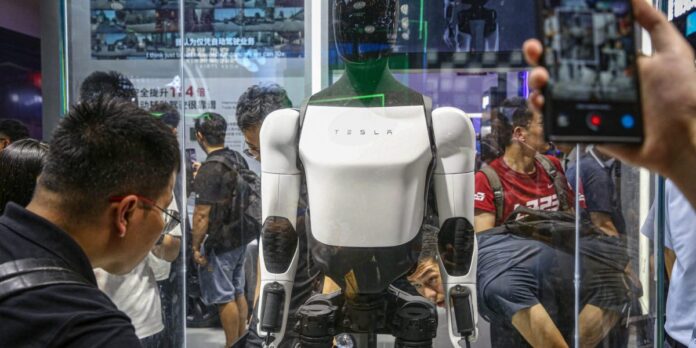Tesla is looking to advance its humanoid Optimus robots by hiring individuals to help in collecting data essential for training Tesla’s AI-powered robots. The company is offering up to $48 per hour for this role, which involves facilitating the automation of tasks in Tesla factories.
As per various job listings on LinkedIn, Indeed, and Tesla’s website, individuals referred to as “data collection operators” are sought after to gather movement data and provide feedback on the Optimus robots. These operators are required to wear motion-capture suits and VR headsets to imitate the movements of the robots. The job entails walking for over seven hours a day and requires individuals to be between 5’7″ and 5’11″ to operate the motion-capture suits. Payment ranges from $25.25 to $48 per hour.
In a video posted on Tesla’s social media in May, workers wearing motion-capture and VR gear are seen alongside the Optimus bots, practicing tasks such as lifting and placing items. The robots are demonstrated walking and completing tasks like folding laundry independently.
Tesla introduced the Optimus project in 2021 with the aim of automating factory tasks that are deemed unsafe, repetitive, or tedious. This initiative aligns with the increasing industry-wide interest in automation due to labor shortages resulting from the pandemic. While 10% of warehouses were reported to utilize significant automation technology in 2016, robot shipments are projected to rise annually by up to 50% until 2030.
Despite Tesla’s efforts in automation, the Optimus project has faced delays similar to Musk’s other ventures. Musk had suggested production could begin as early as 2023, but the timeline has not been met. Initial reviews of the 2022 Bumble C prototype were disappointing to roboticists, who found the machine underwhelming.
Advancements have been made in the Optimus project since then. The latest iteration of the robot successfully performed its first autonomous task handling batteries at a Tesla facility, as per the company’s 2024 second-quarter earnings report. Musk indicated in July that the robots would be in production for internal use next year, with plans to sell them to other companies by 2026.
Optimus optimism
Musk envisions a significant impact from the Optimus robots on Tesla’s operations, with the potential to drive the company to a $25 trillion valuation. Musk estimated production of over 20 billion units, anticipating high demand from the global population and industrial sectors.
Competition in the field of task-automating robots is intensifying. Figure, another AI-powered robotics firm, recently secured a substantial funding round and a commercial agreement with BMW. To stay ahead, Tesla will need to continuously update and develop new prototypes for the Optimus robots, a challenging endeavor that requires significant investment and poses inherent risks.
Subscribe to the CEO Daily newsletter for free to receive high-level insights for high-powered executives. Subscribe now.




